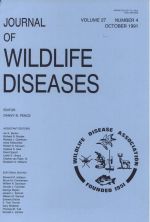We tested the hypothesis that wildfowl activities can influence the risk of avian cholera (Pasteurella multocida infection) for susceptible birds at Centerville, Humboldt County, California (USA). Avian cholera mortality characteristics from past epizootics were correlated with variations in flock size, habitat use and 11 feeding and nonfeeding behaviors among six empirically defined groups of wildfowl: American coots (Fulica americana), tundra swans (Cygnus columbianus), American wigeon (Anas americana), northern pintails (A. acuta), northern shovelers (A. clypeata)/mallards (A. platyrhynchos), and teal (A. discors, A. crecca, A. cyanoptera). The position of these wildfowl groups in past mortality sequences was directly correlated with mean flock size, time spent on land, and time spent grazing on land or in shallow water. We propose that variations in bird density, habitat use and frequency of grazing may serve as predisposing factors to avian cholera among wildfowl.
How to translate text using browser tools
1 October 1991
CORRELATIONS OF DAILY ACTIVITY WITH AVIAN CHOLERA MORTALITY AMONG WILDFOWL
Shawn M. Combs,
Richard G. Botzler

Journal of Wildlife Diseases
Vol. 27 • No. 4
October 1991
Vol. 27 • No. 4
October 1991
American coots
Anas spp.
avian cholera
behavioral ecology
Cygnus columbianus
epizootiology
Fulica americana




